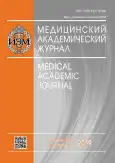ВЛИЯНИЕ ХЕМОКИНА CXCL-13 НА КЛИНИЧЕСКОЕ И ФУНКЦИОНАЛЬНОЕ СОСТОЯНИЕ ПАЦИЕНТОВ С РАССЕЯННЫМ СКЛЕРОЗОМ В СТАДИИ РЕМИССИИ
- Авторы: Сурсякова НВ1, Куклина ЕМ2, Байдина ТВ1, Некрасова ИВ2
-
Учреждения:
- ФГБОУ ВО «Пермский государственный медицинский университет им. акад. Е.А. Вагнера» Минздрава России
- «Институт экологии и генетики микроорганизмов Уральского отделения Российской академии наук» - филиал ФГБУН Пермского федерального исследовательского центра Уральского отделения РАН
- Выпуск: Том 19, № 1S (2019)
- Страницы: 117-119
- Раздел: Статьи
- Статья опубликована: 15.12.2019
- URL: https://journals.eco-vector.com/MAJ/article/view/19356
- ID: 19356
Цитировать
Полный текст
Аннотация
Введение. СXCL-13 может быть вовлечен в развитие РС, а его уровень в периферической крови может иметь диагностическое и/или прогностическое значение. Цель настоящего исследования - оценить уровень CXCL-13 в сыворотке крови и его связь с клиническим и функциональным состоянием пациентов с ремитирующим РС в стадии ремиссии. Материалы и методы. В исследовании приняли участие 67 пациентов (28 мужчин и 39 женщин) с ремиттирующим рецидивирующим типом течения РС в стадии ремиссии. У всех пациентов было проведено обследование по шкалам и акетам EDSS, Multiple Sclerosis Functional Composite, Multiple Sclerosis Impact Scale 29, Fatigue Severity Scale. В день проведения клинического обследования у пациентов и здоровых доноров были взяты пробы венозной крови, выделена сыворотка и оценен уровень СXCL-13 методом иммуноферментного анализа. Результаты. Выявлено, что CXCL-13 в сыворотке пациентов с РС достоверно ниже, чем у здоровых добровольцев. Обнаружена связь уровня CXCL-13 в сыворотке с выраженностью неврологического дефицита по ЕDSS, со скоростью ходьбы на 25 футов, с оценкой качества жизни по МSIS 29 и утомляемостью по FSS. Выводы. Несмотря на связь СXCL-13 с клиническим и функциональным состоянием больных РС, в настоящее время нельзя рассматривать данный хемокин в качестве диагностического или прогностического маркера при исследуемой патологии.
Ключевые слова
Полный текст
Об авторах
Н В Сурсякова
ФГБОУ ВО «Пермский государственный медицинский университет им. акад. Е.А. Вагнера» Минздрава России
Е М Куклина
«Институт экологии и генетики микроорганизмов Уральского отделения Российской академии наук» - филиал ФГБУН Пермского федерального исследовательского центра Уральского отделения РАН
Т В Байдина
ФГБОУ ВО «Пермский государственный медицинский университет им. акад. Е.А. Вагнера» Минздрава России
И В Некрасова
«Институт экологии и генетики микроорганизмов Уральского отделения Российской академии наук» - филиал ФГБУН Пермского федерального исследовательского центра Уральского отделения РАН
Список литературы
- Disanto G, Morahan J, Barnett M, et al. The evidence for a role of B cells in multiple sclerosis. Neuro¬logy. 2012;78(11):823-832.
- Havenar-Daughton С, Lindqvist М, Heit А, et al. CXCL13 is a biomarker of germinal center activity. Proceedings of the National Academy of Sciences. 2016;113(10):2702-2707.
- Shi G, Zhang Z, Li Q. New Biomarkers in Autoimmune Disease. Journal of Immunology Research. 2017;2017:1-2.
- Ragheb S, Li Y, Simon K, et al. Multiple sclerosis: BAFF and CXCL13 in cerebrospinal fluid. Multiple Sclerosis Journal. 2011;7(7):819-829.
- Edwards KR, Goyal J, Plavina, et al. Feasibility of the Use of Combinatorial Chemokine Arrays to Study Blood and CSF in Multiple Sclerosis. PLoS ONE. 2013;8(11):10-13.
- Novakova L, Axelsson M, Khademi M, et al. Cerebrospinal fluid biomarkers as a measure of disease acti¬vity and treatment efficacy in relapsing-remitting multiple sclerosis. J. Neurochem 2017;141:296-304.
Дополнительные файлы







